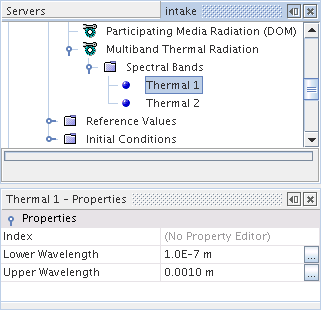Multiband Thermal Radiation Model Reference
The Multiband Thermal radiation model makes it possible to simulate diffuse and specular radiation that is dependent on wavelength or frequency. With this model, wavelength bands specify radiation properties of the media and surrounding surfaces.
The number and extents of bands are chosen to describe property variations with respect to wavelength. During the solution process, the governing radiation equations are solved for each defined band using the specified properties. The total radiation solution is then obtained by integrating (summing) the solutions from each of the individual bands. Because the governing equations are solved for each band, the radiation solution time generally increases linearly with the number of bands. As a consequence, a trade-off often exists between accuracy and computational time.
Absorption is a phenomenon which describes energy being removed from the incident radiative energy by the material or boundary. Absorptivity is a property which is the ratio of the radiative energy that is absorbed to the total radiative energy incident on a boundary. For a surface, the absorptivity dictates absorption whereas for participating media, the absorption coefficient dictates absorption. From Kirchhoff’s Law, the spectral directional emissivity is equal to the spectral directional absorptivity. In Simcenter STAR-CCM+, directional properties are not used so Kirchhoff’s Law is implemented as spectral emissivity is equal to the spectral absorptivity. So for each band in a multiband model the emissivity equals the absorptivity. For a gray model, the properties are independent of both direction and wavelength and emissivity equals absorptivity for the entire spectrum.
The bands for the Multiband model are defined using the Spectral Bands sub-node.
| Theory | See Theory Guide—Radiation Equilibrium. | ||
| Provided By | |||
| Example Node Path | |||
| Requires |
|
||
| Properties |
|
||
| Activates | Model Controls (child nodes) | ||
| Boundary Inputs | See Boundary Settings. | ||
| Field Functions | Direct Directional Incident Radiation, Direct Directional Incident Radiation of <band-name>, Scattering Asymmetry Parameter. See Radiation Field Functions Reference. | ||
Boundary Settings
- Inflow, Outflow, Free Stream Boundaries, and Wall
-
- Diffuse Radiation Flux
- The diffuse radiation flux specified as a scalar profile. Requires the Multiband Thermal Radiation or Gray Thermal Radiation model. See Diffuse Radiation Flux.
- Surface Emissivity
- The ratio of the power that a body emits to the power it would emit as a black body at the same temperature. See Emissivity.
- Surface Reflectivity
- The ratio of reflected radiant energy over incident radiant energy at a given surface. See Reflectivity.
- Surface Transmissivity
- The ratio of transmitted radiant energy over incident radiant energy at a given surface. See Transmissivity.
Spectral Bands
When Multiband Thermal Radiation is activated, spectral bands are used to describe the discretization of the radiation spectrum. The spectrum is divided into a number of discrete bands, each defined by a lower and an upper wavelength. Surface and media properties can be different in each band. The number of bands and their extents must be chosen to represent variations in radiation properties with respect to wavelength. However, as mentioned before, radiation solution time increases linearly with the number of bands so a trade-off often exists between accuracy and runtime.
The Spectral Band node is located under the Multiband Thermal Radiation node. Individual bands are added to this manager node by right-clicking the node and then by selecting New. After a new band is created, its lower and upper wavelength extents can be specified under the band properties.

The rules for defining bands are:
- For an individual band, the lower wavelength must be smaller than the upper wavelength.
- Bands cannot overlap one another.
In general, the bands must be contiguous and span the relevant part of the wavelength domain for the characteristic temperatures of the analysis. (See Planck’s distribution in a standard radiation textbook.) The relevant domain for thermal radiation is typically located between 0.1-1000 micro meters, but it can be narrower depending on the characteristic temperatures.
- If radiation is activated in more than one continuum, the set of bands in each continuum must be the same. This rule can be met by defining the spectral bands in one continuum and then copying the bands to any other continua.
AMG Linear Solver Defaults
For the Multiband Thermal Radiation model, the default value for Cycle Type is Flex Cycle and the Convergence Tolerance is tightened during the first outer iteration by the DO Radiation solver, to propagate the stored spectral solution on the boundary to the participating media. See AMG Linear Solver Reference and The DO Radiation Solver.